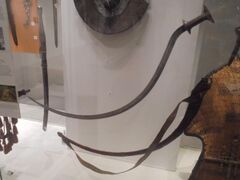Shotel
Topic: Engineering
 From HandWiki - Reading time: 3 min
From HandWiki - Reading time: 3 min
A shotel (Ge'ez & Amharic: ሽቶል/ሽተል) is a curved sword originating in Eritrea and northern Ethiopia. The curve on the blade varies from the Persian shamshir, adopting an almost semicircular shape. The blade is flat and double-edged with a diamond cross-section. The blade is about 40 inches (1,000 mm) in total length and the hilt is a simple wooden or rhinoceros horn piece with no guard similar to the jile or jambiya. The shotel was carried in a close fitting leather scabbard which was often decorated in precious metals and worn on the right side.[1]
History
Evidence of the shotel dates to Dʿmt and the Axumites, having been used by both mounted and unmounted warriors and used dating as far back as 700 BC.[citation needed] After the Solomonic restoration of Atse Yekuno Amlak, the resurgent emperors began to organize their armies in a similar manners to the Aksumites, culminating in the reign of Atse Amda Seyon I. Shotel wielders, known as shotelai or hanetay and organized in the Axurarat Shotelai, comprised one of the elite forces of Amda Seyon's Imperial host. Along with the Hareb Gonda and Korem cavalry, Keste Nihb archers and Axuarat Axuarai lancers were said to be the forces that "flew through the air like the eagle and spun on the ground like the avalanche", by a contemporaneous historian.[citation needed] Shotel techniques among others included hooking attacks both against mounted and dismounted opponents that had devastating effect especially against mounted cavalry. The shotel could be used to hook and rip the warrior off the horse. Classically, the shotel was employed in a dismounted state to hook the opponent by reaching around a shield or any other defensive implement or weapon.[1]
Due to increased trade with the west, over time the shotel began to be replaced in the southern Kingdom of Shewa and Shewan dominated Ethiopian Empire by swords fitted with European sabre blades known as Gurade or Gorade. In Amhara culture the generic word for sword, "seif," is mainly used to refer to a straight bladed, double edged sword.
Design
Its shape, similar to a large sickle, was effectively used to reach around an opponent's shield and stab them in vital areas such as the kidneys or lungs. While closely resembling the Afar gile, the gile has two cutting edges, while the shotel's upper edge is unsharpened and sometimes braced against the swordsman's shield for strength. The shotel and other Eritrean and northern Ethiopian swords are occasionally referred to collectively in Geez as han'e.
The mid-18th century European visitor to Eritrea and northern Ethiopia, Remedius Prutky, often used the word shotel to describe a carving knife.[2]
See also
- Sickle sword, a similar weapon used by the Bronze Age Canaanites, Israelites and Ancient Egyptians
- Falx, a curved weapon used by the ancient Thracians
References
- ↑ 1.0 1.1 *Stone, George Cameron (1999). A Glossary of the Construction, Decoration, and Use of Arms and Armor in All Countries and in All Times. Mineola NY: Dover Publications. p. 562. ISBN 0-486-40726-8.
- ↑ J.H. Arrowsmith-Brown (trans.), Prutky's Travels in Ethiopia and other Countries with notes by Richard Pankhurst (London: Hakluyt Society, 1991), pp. 77, 165.
External links
- "Shotel Sword from Eritrea and northern Ethiopia". Oriental-Arms. http://oriental-arms.co.il/item.php?id=569.
 |
 KSF
KSF
